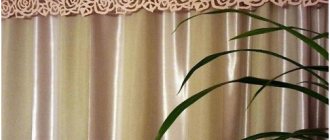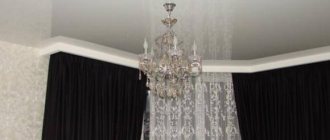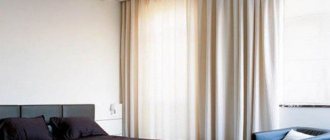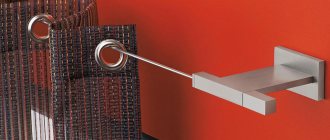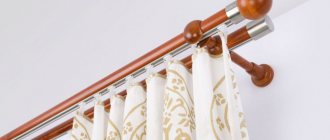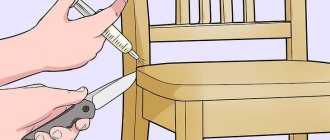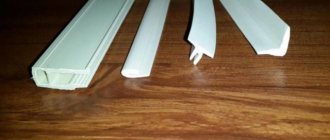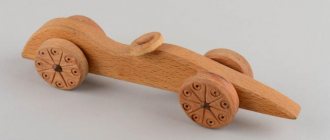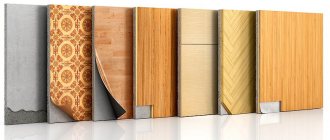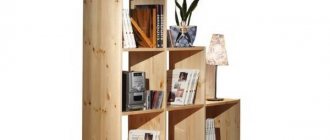Round cornice
It is a long round stick with clamps in the form of rings. It is widely used in country and Provence styles. Beautiful details on the surface of the wood add an element of luxury to the design of the room.
Large ring retainers hold any type of curtain perfectly. Heavier fabrics combined with weightless tulle will help highlight the beauty of this design.
Features of choice
When choosing a cornice, it is important to consider the following nuances:
- Its shade should be harmoniously combined with furniture, wall decoration and curtain color. To emphasize interesting curtains, it is allowed to use a contrasting cornice.
- Light-colored products are appropriate in small rooms. In a large one, you can hang massive cornices, decorated with carvings, forging or decorated with metal parts.
- In order for the curtains to protect the room from the penetration of cold air from the street, it is worth choosing rounded models that have an original appearance.
- Carved cornices and curtains must match each other. Having chosen a massive composition made of dense, heavy fabric, you need to choose a large curtain. And vice versa.
When choosing, keep in mind that the curtains with the cornice should be harmoniously combined.
Ceiling cornice
This model is in great demand among consumers. The structure is mounted under the ceiling. This model visually increases the living space. It is often chosen for apartments with low ceilings.
As for textiles, it is best to choose plain models. The presence of a pattern can reduce the window space several times.
Roof cornice - purpose, structure and finishing methods
No wonder people have said since ancient times that the most important thing is a reliable roof over your head. Professional roofing craftsmen also confirm that only a reliable, durable roof ensures comfortable living in the house. Moreover, the reliability and durability of this complex structure sometimes depends on seemingly very insignificant elements.
For example, the roof cornice, despite its small size and percentage of the surface area of the slopes, this element performs important functions that affect the service life, insulating ability and strength of the roof. In this article we will talk about the design of the roof eaves of a house, methods of its formation and optimal dimensions.
Wall cornice
This variety has good performance qualities. The design can be either single-row or double-row. It can be found in classic design. The front part of such a cornice is usually decorated with many decorative elements.
For a minimalist style, a cornice in the form of a rectangular stick is suitable. Here the surface has a smooth base without any unnecessary details.
Wooden carved frames
Another way to decorate the interior with elements of carved decor is wooden trim on doors and windows. Typically, trim consists of three or four boards that frame a door or window opening.
If the side boards are usually carved moldings, the top board can be distinguished by a large number of decorations; it crowns the door and protrudes somewhat above the main plane.
Decorative carved wood frames are suitable for many interiors. Depending on the pattern and other details, you can embody not only a classic or Russian style, but also a country style, oriental, Arabic, Japanese and others.
You need to choose platbands taking into account the door. A wide door requires an appropriate frame with more visible elements. In this case, it is not necessary to choose an identical shade of the trim and the door, but it is necessary that the colors be close to each other.
Blanks of wooden carved platbands
In this case, the casing should be darker, but not vice versa.
Carved overlays for platbands
Carved overlays - small elements carved from wood of the most varied types: leaves, curls, flowers and any fancy patterns - will help make a simple wooden frame original.
A finished and beautiful look will be given by special corner overlays on the platbands, which not only give the opening a decorative effect, but also cover the joints.
Material selection
The most suitable material for carving is linden, alder or aspen. The wood of these species is soft, pliable, homogeneous and allows you to create the finest patterns. Dried wood becomes strong and does not warp.
Pine is also traditionally chosen for platbands - it is affordable, has good performance properties, medium density and is quite easy to process.
Pine is more suitable for frames with a larger pattern; small details will be lost in its pronounced texture. True connoisseurs prefer to choose noble oak, even despite its high cost.
The advantage of a wooden cornice
Experienced designers highlight several main advantages of such designs:
- aesthetic appearance. Agree that beautiful textiles are in perfect harmony with natural wood. As a result, the interior space will sparkle with new colors;
- comfortable shape;
- natural materials in the structure;
- textured base;
- decorative appearance;
- quality parts.
The presence of small details on the surface of the cornice helps to add a unique twist to the living area. Large models decorated with complex multi-layer carvings look perfect. Here, every element fills the atmosphere with warmth and comfort. This cornice will become a real decoration for your home.
As for the color palette, it can be varied. It is recommended to select colors for the cornice in accordance with the main colors of the interior.
How to install correctly
You need to hang the cornice in stages:
- Make markings where it is attached to the wall or ceiling.
- Attach the brackets. If the wall is concrete, use dowels with spacers. Self-tapping screws are suitable for drywall, and plastic bushings are suitable for foam blocks.
- Assemble the cornice and hang it on the prepared brackets.
The cornice must be installed in accordance with specific instructions. Curtain rods made of wood need proper care. To prevent the product from swelling and losing its original appearance, it must be protected from direct exposure to moisture. It is important to wipe them regularly with a soft cloth and soapy water. Protective impregnations are periodically used. Powders and aggressive chemicals are not suitable for caring for cornices.
To maintain the appearance of the product, it requires systematic care. Curtain rods made of natural wood are environmentally friendly and have an attractive appearance. When choosing them, you need to take into account the size of the room, ceiling height and overall interior design. With proper care, such a product can last a very long time.
The main advantage of wood cornices is that they are environmentally friendly.
What is special about wooden cornices?
The appearance of the finished product directly depends on the material from which it is made. If oak or cedar is present in the design, then a strict and laconic atmosphere appears in the room, which can convey all the richness of this texture.
A double-row wooden cornice made of mahogany is able to convey the refined taste of its owners. Every detail emphasizes status and solidity. The combination of expensive wood with high-quality textiles creates a truly luxurious interior.
Classic models are made from solid pine or alder. On the surface there is a large number of decorative details with elements of gilding. It can be used to decorate a bedroom, living room or children's room.
How to make wooden curtains with your own hands
Making a wooden curtain rod with your own hands is not difficult. To do this you need to prepare the following materials:
- 2 slats;
- 2 metal corners;
- self-tapping screws
To make your own cornice, you will need wooden slats. Additionally, you will need a saw, a hacksaw, a screwdriver, wire for attaching hooks, a ruler and varnish for wood processing.
You will need to prepare the necessary tools. The process of making a cornice with your own hands is as follows:
- Length notes are made on the staff.
- The excess is sawed off.
- Corners are attached to the sides. Experts advise attaching two pairs at once, from below and from above.
- Wooden elements are attached to the corners.
- Guides are installed. To secure the wire tightly, its length must be 5 cm greater than the length of the cornice.
- The number of guides depends on personal preference. Self-tapping screws are used to secure the strings.
- At the very end, the cornice is treated with a layer of varnish. It is advisable to repeat the procedure 3 times.
At the end, the finished product must be varnished.
Optimal size
It is often difficult for non-professional craftsmen to determine what size cornice to make. This is indeed a very important design decision, because if it is too small, then melt or rain water from the slope will fall on the lining of the external walls, on the foundation blind area, leading to destruction and also damage to the appearance of the structure. When choosing the length of the cornice, the following factors are taken into account:
- Climatic conditions. The optimal size of the roof eaves depends on the amount of precipitation falling in winter and summer. In snowier regions, roofs with wide eaves are traditionally used to protect the walls and foundation from snow. For example, alpine chalets located in the mountains usually have eaves overhangs at least 1 meter wide.
- Roof slope. The greater the angle of inclination of the roof slopes, the smaller the cornice can be made. This is explained by the fact that with a flat roof shape, the trajectory of falling snow and water goes far from the outer walls of the house. If the slopes are steep enough, then it is better to make the cornices wider to protect the structure from splashes of water that can reach the wall during intense snowmelt or rainfall.
- Proportions of the house. A wide cornice with a flat roof makes the building visually lower, squat, distorting the optimal proportions. A narrow overhang with a high, steep roof, on the contrary, elongates the silhouette of the house.
Important! The minimum permissible width of cornices is 45-50 cm, but this is clearly not enough for regions with high snow loads. If necessary, the size of this structural element is increased to 1 m.
